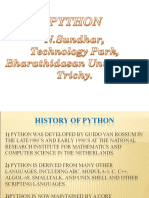0 ratings0% found this document useful (0 votes)
3 viewsPython Notes
The document provides an overview of basic programming concepts including data types such as float, integer, string, boolean, and list. It explains list operations like pop, remove, append, and insert, as well as control flow statements like if, elif, and else. Additionally, it covers comparison operators and the break statement in programming.
Uploaded by
william-dcostaCopyright
© © All Rights Reserved
We take content rights seriously. If you suspect this is your content, claim it here.
Available Formats
Download as TXT, PDF, TXT or read online on Scribd
0 ratings0% found this document useful (0 votes)
3 viewsPython Notes
The document provides an overview of basic programming concepts including data types such as float, integer, string, boolean, and list. It explains list operations like pop, remove, append, and insert, as well as control flow statements like if, elif, and else. Additionally, it covers comparison operators and the break statement in programming.
Uploaded by
william-dcostaCopyright
© © All Rights Reserved
We take content rights seriously. If you suspect this is your content, claim it here.
Available Formats
Download as TXT, PDF, TXT or read online on Scribd
You are on page 1/ 1
LESSON 1
print("any characters exept \") --- writes whatever you want
\n --- new line
float --- decimal number
integer --- regular, non decimal number
string --- any character(s) except \
boolean--- can be set to True or False
list --- ["hi", 0, 1.0, True] --- can store any input. True and False do not
inverted commas unlike string
print(type(...)) --- tells you what data type it is
input(...) --- is the input
int --- makes the input have to be a number
LESSON 2
listVar --- A variable list
listVar.pop() --- removes the last item in the list
listVar.remove() --- removes whatever you specify
listVar.append() --- adds whatever you specify except \ in a string
listVar.insert(num, elem) --- num is the position number (1=0 in python, 1=2 irl),
elem is what you add in that position
print(listVar[:]) --- keeps items until the second number
print(listVar[]) --- only keeps the item number written
LESSON 3
if --- if statement
elif --- short for else if
else --- if something other than the the if occurred
== --- is exactly
!= --- is not
> --- is bigger than
< --- is smaller than
>= --- is bigger than or equal to
<= --- is smaller than or equal to
LESSON 4
break -- whatever written directly after does not occur
You might also like
- Python Fundamentals For Machine Learning Version1No ratings yetPython Fundamentals For Machine Learning Version158 pages
- 5.lists: 5.1. Accessing Values in Lists ExNo ratings yet5.lists: 5.1. Accessing Values in Lists Ex8 pages
- Artificial Intelligence_05-FEB-2024_jbGa5opMefANo ratings yetArtificial Intelligence_05-FEB-2024_jbGa5opMefA6 pages
- Lab Task # 3 Introduction To Programming With PythonNo ratings yetLab Task # 3 Introduction To Programming With Python12 pages
- 01-139232-096-134033109426-23022025-110952pmNo ratings yet01-139232-096-134033109426-23022025-110952pm48 pages
- SYBSc(CS) Electronics Practical Sem IV Introduction to PythonNo ratings yetSYBSc(CS) Electronics Practical Sem IV Introduction to Python23 pages
- Python Cheat Sheet - Lecture Notes 1-19 Python Cheat Sheet - Lecture Notes 1-19No ratings yetPython Cheat Sheet - Lecture Notes 1-19 Python Cheat Sheet - Lecture Notes 1-194 pages
- ITE 260 SAS Day 04 Data and ExpressionsNo ratings yetITE 260 SAS Day 04 Data and Expressions12 pages
- Unpack A Collection: "Orange" "Banana" "Cherry"No ratings yetUnpack A Collection: "Orange" "Banana" "Cherry"37 pages



























































